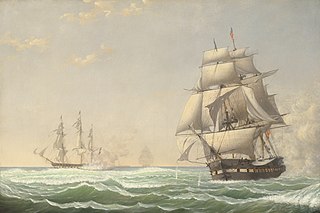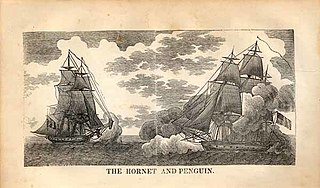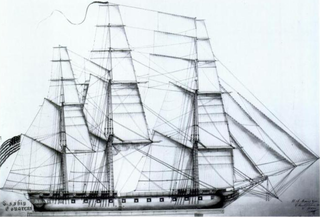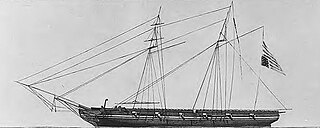
USS Wasp of the United States Navy was a sailing sloop-of-war captured by the British in the early months of the War of 1812. She was constructed in 1806 at the Washington Navy Yard, was commissioned sometime in 1807, Master Commandant John Smith in command. In 1812 she captured HMS Frolic, but was immediately herself captured. The British took her into service first as HMS Loup Cervier and then as HMS Peacock. She was lost, presumed foundered with all hands, in mid-1814.

The third USS Hornet was a brig-rigged sloop-of-war in the United States Navy. During the War of 1812, she was the first U.S. Navy ship to capture a British privateer.

USS Peacock was a sloop-of-war in the United States Navy during the War of 1812.

The sinking of HMS Peacock was a naval action fought off the mouth of the Demerara River, Guyana on 24 February 1813, between the sloop of war USS Hornet and the Cruizer-class brig-sloop HMS Peacock. After an exchange of broadsides, Hornet was able to rake Peacock, forcing her to strike. Peacock was so badly damaged that she sank shortly after surrendering.

The capture of HMS Frolic was a naval action fought in the Atlantic on 18 October 1812, between the sloop-of-war USS Wasp, commanded by Master Commandant Jacob Jones, and the Cruizer-class brig-sloopHM Brig Frolic, under Commander Thomas Whinyates. The Americans captured the British vessel, but both vessels shortly thereafter were captured by a British ship of the line which happened upon the scene of the battle.

The capture of HMS Epervier was a naval action fought off the coast of Florida near Cape Canaveral on 28 April 1814, between the United States ship-rigged sloop-of-war USS Peacock, commanded by Master Commandant Lewis Warrington, and the British Cruizer-class brig-sloop Epervier under Commander Richard Wales. The Americans captured the British vessel after a one-sided cannonade, but the British merchant convoy escaped.

The capture of USS President was one of many naval actions fought at the end of the War of 1812. The frigate USS President tried to break out of New York Harbor but was intercepted by a British squadron of four warships and forced to surrender.

On 23 March 1815 USS Hornet captured HMS Penguin in a short battle off Tristan da Cunha. It was one of several engagements that took place after the War of 1812 had ended, and was the final action between British and American forces. The American gunnery was far more effective than the British, despite the two vessels being virtually identical in strength. After exchanges of broadsides and musket fire, the British commander was killed. The British brig rammed the American ship in an attempt to board, but the two were separated and Penguin was disabled shortly afterwards when the foremast fell, forcing the British to surrender. The British brig was too badly damaged to be salvaged and was set ablaze by the victors after its stores and surviving crew were removed.

HMS Frolic was an 18-gun Cruizer-class brig-sloop of the Royal Navy. She was built by Boole, of Bridport and was launched on 9 February 1806. Although she took part in the capture of Martinique, Guadaloupe, and Saint Martin, she appears to have had an uneventful career until 8 October 1812, when the American sloop-of-war USS Wasp captured her after a fierce fight. Later that day the British recaptured Frolic and captured Wasp. Frolic was broken up in 1813.

HMS Epervier was an 18-gun Cruizer-class brig-sloop of the Royal Navy, built by Ross at Rochester, England, and launched on 2 December 1812. USS Peacock captured her in 1814 and took her into service. USS Epervier disappeared in 1815 while carrying dispatches reporting the signing of a treaty with the Dey of Algiers.

HMS Penguin was a Royal Navy Cruizer-class brig-sloop launched in 1813. In 1815 USS Hornet captured Penguin in a battle that took place after the end of the War of 1812. Hornet then scuttled Penguin as she was too damaged to merit keeping.

The West Indies Squadron, or the West Indies Station, was a United States Navy squadron that operated in the West Indies in the early nineteenth century. It was formed due to the need to suppress piracy in the Caribbean Sea, the Antilles and the Gulf of Mexico region of the Atlantic Ocean. This unit later engaged in the Second Seminole War until being combined with the Home Squadron in 1842. From 1822 to 1826 the squadron was based out of Saint Thomas Island until the Pensacola Naval Yard was constructed.

The West Indies Anti-Piracy Operations refer to the United States Navy presence in the Antilles, and surrounding waters, which fought against pirates. Between 1814 and 1825, the American West Indies Squadron constantly pursued pirates on sea and land, primarily around Cuba and Puerto Rico.After the capture of Roberto Cofresi in 1825, acts of piracy became rare, and the operation was considered a success, although limited occurrences went on until slightly after the start of the 20th century.

Stephen Decatur Jr. was an American naval officer and commodore. He was born on the eastern shore of Maryland in Worcester County. His father, Stephen Decatur Sr., was a commodore in the United States Navy who served during the American Revolution; he brought the younger Stephen into the world of ships and sailing early on. Shortly after attending college, Decatur followed in his father's footsteps and joined the U.S. Navy at the age of nineteen as a midshipman.

HMS Julia was a British Royal Navy 16-gun brig-sloop of the Seagull class launched in February 1806. After a fairly uneventful decade-long career she was wrecked at Tristan da Cunha in 1817 with heavy loss of life.

HMS Peacock was a Cruizer-class brig-sloop of the Royal Navy. She was launched in 1806 and had a relatively uneventful career until she had the misfortune to encounter USS Hornet in February 1813. Hornet captured Peacock, which then sank.
The capture of East India Company brig Nautilus took place on 30 June 1815. Although part of the Anglo-American War of 1812, it took place long after the war ended, as the commander of the United States Sloop of war USS Peacock was unaware that the war had ended six months earlier.
Blenden Hall was a full-rigged ship, launched in 1811 at Bursledon, Hampshire, England. A French frigate captured her in 1813, but then abandoned her. After her recovery she returned to trade. She was wrecked in 1821 on Inaccessible Island in a notable incident.
HMS Alert was the collier Oxford, launched at Howdon in 1803 that the Royal Navy purchased in 1804 and renamed HMS Alert. She had a mundane career in the Royal Navy escorting convoys until in 1812, shortly after the outbreak of the War of 1812, she had the misfortune to encounter the frigate USS Essex, which captured Alert. The US Navy used Alert as a storeship and a receiving ship until it had her broken up in 1829.

Asia was built at Bombay Dockyard in 1797. She made at least two voyages for the British East India Company (EIC) before the British Royal Navy purchased her in 1805 in the East Indies. The Royal Navy renamed her HMS Sir Francis Drake and used her as a frigate. She served in the Java campaign of 1811. When she returned to England in 1813 she was refitted as a storeship. Later, she became the flagship, at Newfoundland, for the governors of Newfoundland. The Admiralty sold her in 1825. New owners renamed her Asia and she sailed between Britain and London until 1831 when Portuguese interests purchased her. She then became the frigate Dona Maria II for the Liberal forces that were attempting to install the rightful queen, Dona Maria II, to the throne of Portugal, and overthrow Dom Miguel, who had usurped the throne. In early 1849 conflict developed between the Portuguese government in Macau and the Chinese government over who could collect taxes and tariffs at Macao. Dona Maria II sailed to Macao as part of a small squadron. An internal explosion destroyed her in the harbour on 29 October.













